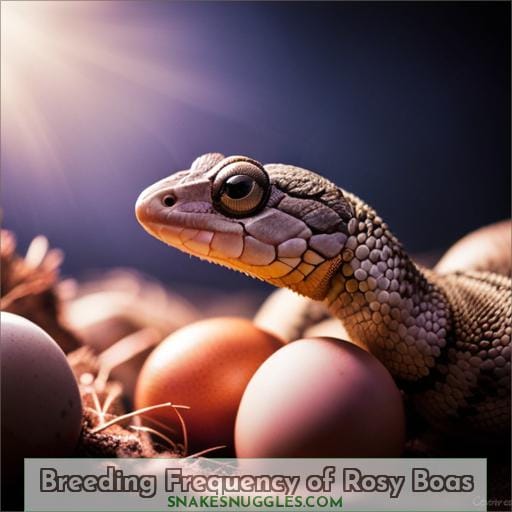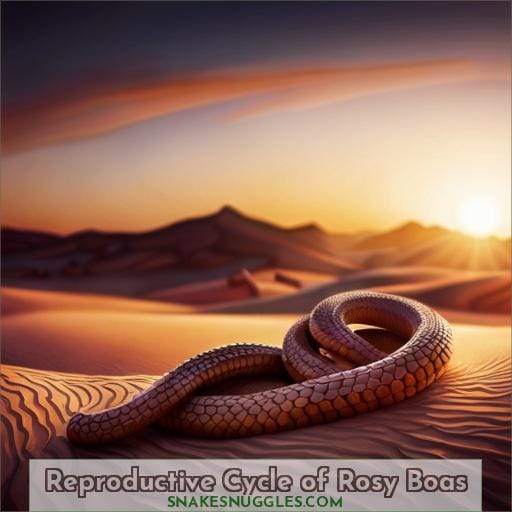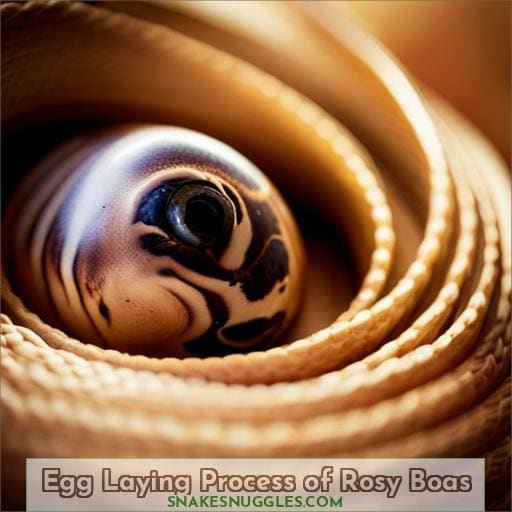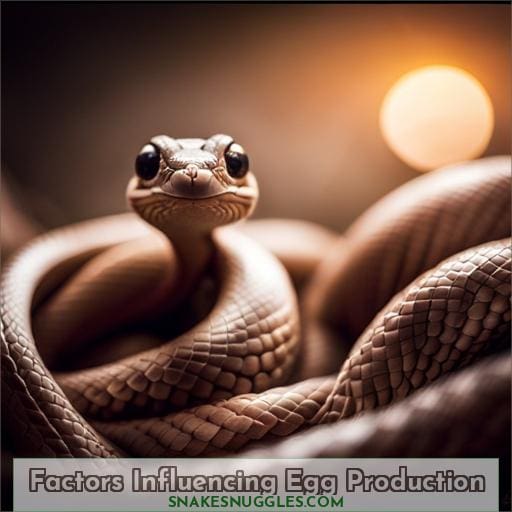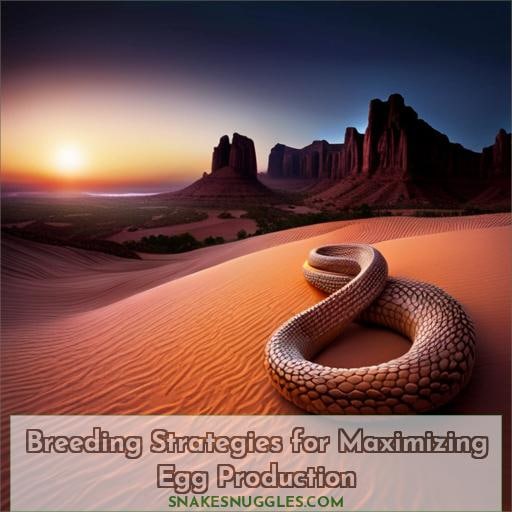This site is supported by our readers. We may earn a commission, at no cost to you, if you purchase through links.
 Curious about the reproductive habits of rosy boas? Wondering how often these beautiful snakes lay eggs? Well, let’s dive right in and explore the fascinating world of rosy boa reproduction.
Curious about the reproductive habits of rosy boas? Wondering how often these beautiful snakes lay eggs? Well, let’s dive right in and explore the fascinating world of rosy boa reproduction.
Contrary to popular belief, rosy boas are viviparous, meaning they give birth to live young instead of laying eggs. On average, female rosy boas tend to breed every other year. However, various factors such as age and environment can influence their breeding frequency.
So buckle up and get ready for some intriguing insights into the egg-laying habits of these captivating creatures!
Table Of Contents
- Key Takeaways
- Breeding Frequency of Rosy Boas
- Reproductive Cycle of Rosy Boas
- Egg Laying Process of Rosy Boas
- Number of Clutches Per Year
- Factors Influencing Egg Production
- Breeding Strategies for Maximizing Egg Production
- Frequently Asked Questions (FAQs)
- What is the average number of eggs per clutch for rosy boas?
- How long does it take for rosy boas to lay their eggs after mating?
- Are there any specific environmental conditions that can stimulate egg production in rosy boas?
- Can rosy boas lay eggs multiple times in a year?
- Are there any factors that can affect the fertility of rosy boa eggs?
- Conclusion
Key Takeaways
- Rosy boas lay eggs once a year.
- The breeding season for rosy boas occurs during spring or early summer.
- Hormonal changes and behaviors are observed in rosy boas during the breeding season.
- Factors such as age, size, temperature, humidity, and husbandry practices influence the egg production of rosy boas.
Breeding Frequency of Rosy Boas
When discussing the breeding frequency of Rosy Boas, there are several factors that can affect how often they lay eggs.
These include:
- Age
- Health
- Environmental conditions
In captivity, it’s typical for Rosy Boas to breed once a year during the spring or early summer months. However, some individuals may have shorter intervals between breeding cycles if conditions are optimal.
Factors That Affect Breeding Frequency
Breeding frequency of Rosy Boas is influenced by various factors.
Environmental influences, such as temperature and lighting, play a crucial role in triggering reproductive cycles.
Additionally, the age and size of the female boa can impact breeding frequency.
Nutritional impact also plays a significant role, as proper nutrition ensures optimal health for successful breeding.
However, captive breeding challenges may arise due to factors like stress or inadequate husbandry practices.
Understanding these factors is essential for maximizing egg production in Rosy Boas.
Typical Breeding Patterns in Captivity
Now let’s delve into how often rosy boas lay eggs in captivity. Do they breed frequently?
In a captive environment, the breeding frequency of rosy boas can vary depending on various factors such as environmental influences and optimal husbandry practices.
Typically, rosy boas have a breeding season that occurs once a year, during which successful mating takes place. After mating, females undergo gestation for approximately 120-140 days before giving birth to live young.
Ensuring proper incubation techniques and providing an ideal captive environment greatly contribute to the breeding success of these fascinating snakes in captivity.
Reproductive Cycle of Rosy Boas
During the reproductive cycle of Rosy Boas, there are distinct hormonal changes and behaviors that occur during the breeding season. These changes play a crucial role in determining how often rosy boas lay eggs. Understanding these patterns can provide valuable insights into their reproductive biology and help breeders successfully manage their breeding programs.
Overview of the Reproductive Cycle
During the reproductive cycle of Rosy Boas, you can expect a series of significant hormonal and behavioral changes.
As the breeding season approaches, males may exhibit increased activity and territoriality.
Females will undergo hormonal shifts that trigger nesting behavior. They may become more restless and seek out suitable sites for egg deposition.
Once eggs are laid, proper incubation techniques must be employed to ensure successful hatching. Environmental influences such as temperature and humidity also play a crucial role in this process.
Hormonal Changes and Behaviors During Breeding Season
Throughout the reproductive cycle of rosy boas, they undergo hormonal shifts and exhibit specific behaviors that are indicative of their breeding season. These seasonal behaviors include courtship rituals such as male combat, where males compete for access to females.
Hormonal changes trigger reproductive cues in both males and females, signaling their breeding readiness.
Understanding these behaviors and hormonal changes is crucial for successful rosy boa care and raising healthy offspring. Proper feeding habits and maintaining an appropriate boa enclosure also play a significant role in facilitating successful reptile breeding.
Egg Laying Process of Rosy Boas
To understand the egg laying process of Rosy Boas, it’s important to consider several key factors.
First, preparing a suitable nesting area is crucial for successful egg laying.
Second, recognizing the signs that indicate impending egg laying can help ensure proper care during this time.
Lastly, understanding the incubation requirements and methods will be essential for successfully hatching and raising healthy rosy boa hatchlings.
Preparing the Nesting Area
To ensure a successful egg laying process, it’s important to prepare a suitable nesting area for your rosy boas.
Consider their nesting preferences and create an environment that meets their needs.
Pay attention to thermal gradients by providing both warm and cool areas in the enclosure.
Choose appropriate substrate options for burrow construction.
Include environmental enrichment such as hide boxes to promote natural behaviors during the egg-laying process.
Signs of Impending Egg Laying
As the nesting area is prepared, you can recognize signs that a rosy boa is about to lay eggs through various behavioral and physiological changes.
- Watch for nesting behaviors such as increased exploration of the enclosure and burrow construction.
- Environmental cues like an increase in humidity levels may also indicate breeding readiness.
- Additionally, observe your snake for signs of restlessness or decreased appetite.
These indicators suggest that egg laying is imminent and it’s important to provide a suitable nesting site for your rosy boa during this time.
Incubation Requirements and Methods
During the incubation period, you’ll need to provide specific conditions and follow certain methods to ensure successful hatching of Rosy Boa eggs.
Maintaining an optimal incubation temperature between 80-85°F is crucial for proper development.
Substrate choices such as vermiculite or perlite can be used in DIY incubators to create a suitable environment for the eggs.
Naturalistic methods, like mimicking natural temperature variation and incorporating brumation periods, can also be employed by reptile enthusiasts.
UVB light shouldn’t be directly exposed during this stage of egg development.
Properly managing the incubation requirements is essential when it comes to successfully hatching Rosy Boa eggs. The most critical factor during this period is maintaining a consistent and appropriate temperature range within the enclosure.
The ideal range for rosy boa egg incubation falls between 80-85 degrees Fahrenheit (27-29 degrees Celsius). This ensures that the embryos develop properly without being subjected to extreme temperatures that could harm their growth.
For substrate choices in DIY incubators, vermiculite or perlite are commonly used options due to their ability retain moisture while providing adequate airflow around each individual egg.
In addition to regulating temperature levels accurately through artificial means, some reptile enthusiasts choose more naturalistic methods as well. These include mimicking variations in environmental temperatures seen in nature or incorporating brumating periods into their breeding practices.
It’s important not expose rosy boa eggs directly under UVB lighting during this stage of development since they don’t require direct exposure at such an early phase.
By carefully monitoring these factors throughout the entire duration of your rosy boas’ pregnancy journey until hatch day arrives,you’re ensuring optimum chances at success!
Number of Clutches Per Year
When it comes to the number of clutches per year, rosy boas typically lay a single clutch in the wild. However, when kept in captivity with optimal conditions and breeding practices, they’ve been known to produce multiple clutches per year.
This increased frequency is attributed to factors such as controlled environmental conditions and selective breeding techniques employed by breeders.
Natural Occurrence in the Wild
In the wild, rosy boas typically lay eggs once per year. Their breeding behavior follows natural reproductive cycles influenced by environmental factors.
These snakes exhibit specific nesting habits and rely on optimal breeding strategies to ensure successful reproduction.
Understanding the number of clutches per year in their natural habitat provides valuable insights into their reproductive patterns and helps inform captive breeding practices for this species.
Environmental influences play a crucial role in determining when and how often rosy boas lay eggs in the wild.
Frequency of Multiple Clutches in Captivity
To understand the breeding habits of Rosy Boas in captivity, it’s important to consider the frequency of multiple clutches they can produce per year.
The reproductive hormones and nesting behavior of these snakes play a significant role in determining their ability to lay multiple clutches.
Additionally, proper incubation techniques and environmental stimuli are crucial for successful egg development.
Breeders often employ specific breeding strategies to maximize egg production, ensuring healthy offspring and maintaining bloodlines.
Factors Influencing Egg Production
The frequency at which Rosy Boas lay eggs is influenced by several factors.
Firstly, the age and size of the female boa play a role in determining how often they reproduce. Older and larger females tend to produce more clutches per year compared to younger or smaller individuals.
Secondly, environmental conditions such as temperature, humidity levels, and photoperiod can also impact egg production.
Lastly, husbandry practices including diet quality, enclosure setup (such as providing appropriate nesting areas), and overall health of the snake are important considerations that affect reproductive output in Rosy Boas.
Age and Size of the Female Boa
As the age and size of the female boa play a crucial role in determining their ability to produce eggs, it’s important for breeders to understand these factors.
- Growth milestones
- Reproductive readiness
- Size-related cues
- Maternal health
- Breeding maturity
It’s essential to monitor the development of female boas closely and provide appropriate care during their growth stages to ensure optimal egg production in captivity.
Environmental Conditions and Husbandry Practices
By maintaining optimal environmental conditions and implementing proper husbandry practices, you can greatly influence the egg production of your female Rosy Boa.
Factors such as temperature, humidity, lighting, enclosure setup, and behavioral cues play a crucial role in stimulating breeding behaviors and promoting successful egg laying.
Creating a suitable habitat with temperature gradients between 80-85°F (hot end) and slightly cooler temperatures at the cool end helps mimic natural conditions. Providing a humid hideout along with appropriate lighting further enhances reproductive success.
| Environmental Factors | Influence on Egg Production |
|---|---|
| Temperature | Stimulates breeding behaviors |
| Humidity | Affects thermoregulation for incubation |
Breeding Strategies for Maximizing Egg Production
To maximize egg production in Rosy Boas, implementing proper nutrition and health care is crucial.
- Providing a balanced diet of appropriately sized prey items
- Ensuring the snakes are kept in optimal physical condition
Additionally, manipulating environmental factors such as temperature and photoperiod can stimulate breeding behavior in these snakes. By carefully managing these aspects, breeders can increase the frequency at which Rosy Boas lay eggs.
Implementing Proper Nutrition and Health Care
To maximize egg production in Rosy boas, you should implement proper nutrition and health care practices.
- Providing a well-balanced diet is crucial, including dietary supplements to ensure essential nutrients are met.
- Regular veterinary checkups help monitor the overall health of your snakes and address any potential issues.
- Habitat enrichment with appropriate hiding spots and climbing opportunities promotes natural behaviors and reduces stress levels.
- Maintaining optimal temperature control within their enclosure is also important for reproductive success.
Manipulating Environmental Factors to Stimulate Breeding
To maximize egg production in Rosy Boas, you can manipulate environmental factors that stimulate breeding.
Temperature manipulation plays a crucial role, as females require a drop in temperature to trigger reproductive activity.
Additionally, providing adequate light exposure and controlling humidity levels are essential for successful breeding.
Simulating seasonal changes through adjustments in lighting and temperature can mimic natural conditions and encourage mating behavior.
Finally, offering appropriate nesting substrates ensures the female boa has a suitable environment for laying her eggs.
Frequently Asked Questions (FAQs)
What is the average number of eggs per clutch for rosy boas?
Rosy boas typically lay clutches of 2-9 eggs, with the average number being around 4-
- Age
- Size
- Overall health of the female boa
How long does it take for rosy boas to lay their eggs after mating?
Rosy boas typically lay eggs 4 to 6 weeks after mating, coinciding with the end of their gestation period. This duration allows for optimal development and ensures successful reproduction in these fascinating snakes.
Are there any specific environmental conditions that can stimulate egg production in rosy boas?
To stimulate egg production in rosy boas, ensure optimal environmental conditions.
- Maintain a temperature gradient of 80-85°F (hot end) and slightly lower on the cool end.
- Provide appropriate humidity levels.
- Provide a suitable nesting area for the female to lay her eggs.
Can rosy boas lay eggs multiple times in a year?
Rosy boas can lay eggs multiple times in a year, typically producing one clutch per breeding season. The frequency of egg-laying depends on various factors like the female’s age, health, and environmental conditions that stimulate reproductive activity.
Are there any factors that can affect the fertility of rosy boa eggs?
Factors such as age, health, and environmental conditions can affect the fertility of rosy boa eggs.
Adequate nutrition, proper temperature gradients, and optimal humidity levels are crucial for successful egg production in these snakes.
Conclusion
To wrap up our exploration of rosy boa reproduction, it’s important to note that these captivating creatures don’t lay eggs but instead give birth to live young.
Female rosy boas typically breed every other year, although this can be influenced by various factors such as age and environment.
Understanding the reproductive cycle, egg-laying process, and factors influencing egg production can help snake enthusiasts maximize the potential for successful breeding.
So, if you’re curious about how often rosy boas lay eggs, remember that they’re viviparous and breed at a frequency influenced by several factors.

